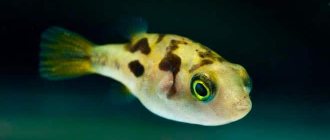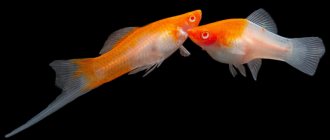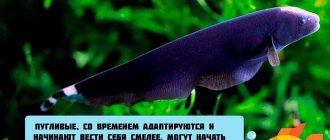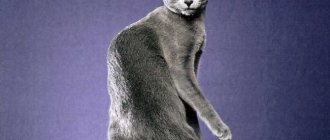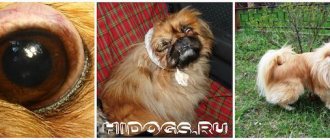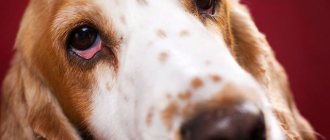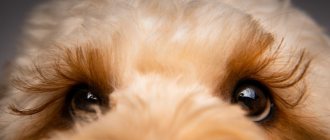The Oranda fish from the Carp family, a variety of Veiltail, is beloved by aquarists for its unusual appearance and beautiful bright colors. The predecessor of the breeding series is Golden Crucian. This variety was bred in Japan in the 15th century, although China is considered its homeland. In Japanese, the name Oranda sounds like "shishiga-shira". The ability to breed specimens of original colors makes it popular among aquarists in all countries, including Russia.
- 1 Description and selection features
- 2 Mr. Tail Recommends: Oranda Varieties
- 3 Basics of aquarium keeping
- 4 Compatibility
- 5 Feeding
- 6 Breeding
- 7 Diseases and prevention
Description
Popular for its unusual appearance, different from the usual Goldfish. The oval body, expanded on the sides, looks like an egg. They grow on average up to 15–20 cm. Of particular value is the bright red wen that covers the top of the head and ends at eye level. When breeding fish, individuals with the largest caps were selected. Until now, the fish that has a larger head with a red wen is considered more valuable. Such representatives are valued at much higher prices.
The color of all representatives is the same - the body is white-pinkish in color with metallic tints. Representatives of other colors are less common.
The fins are translucent and whitish in color. The fish have genes for the veil tail, from which the red cap got a long veil-like tail, often exceeding the length of the body. Individuals with a caudal fin in the form of a skirt are especially valued.
Types of oranda:
- Black oranda. The body color is charcoal black, with gold inclusions.
- Blue oranda. Gray or blue colors.
- Calico oranda. The main color is pale golden-red with chaotic spots of different colors.
- Chocolate oranda. Body color is brown-chocolate.
Behavior
The red cap aquarium fish is a peaceful inhabitant of the aquarium, rarely getting into skirmishes or fights with other residents. Most often, representatives treat others neutrally, not noticing other species. But it loves to swim in the company of its own kind, so it is advisable to keep it in a small flock.
Lifespan
The average lifespan of this aquarium fish is 13-16 years. One record holder lived for more than 40 years.
Popular types
This species has a large number of color shades. So, there are scarlet, gold, orange, white, brown, black fish. Here are some of the most common types of orandas:
Giroshima
It is a beautiful species, having furry growths near the mouth. At the tip of the nose it has a blue, red or white pompom.
Blue
She has a matte body sheen, with a blue spot near her back.
Gray
Silver scales, dark head, fins with rounded ends.
Calico oranda
One of the oldest subspecies. It was obtained by crossing the motley telescope and the oranda. This species requires a larger aquarium.
Black oranda
It has a pronounced growth on the head and is distinguished by a velvety dark color.
Redcaps are beautiful, fast and easy to care for fish. Even a novice aquarist can start them. Compliance with the conditions of detention prolongs their life.
Content
Goldfish have a stigma of being messy. But this is not true, they pollute the aquarium no more than other species and need infrequent cleaning 1-3 times a month. And this myth arose due to the large amount of food consumed.
Caring for the little red cap fish includes weekly replacement of 1/3 of the volume of water in the aquarium.
Aquarium
The size of the aquarium for one Goldfish is 50 liters. For a small flock of several representatives, you will need an aquarium of more than 100–150 liters. The number of decorations should be minimal. Sand and decorative items are also selected taking into account the remaining free space for swimming. Large volume is much more important than cover.
Water parameters
Comfortable temperature is 16–25 degrees. Acidity should not exceed 8 pH and be not lower than 5 pH. Water hardness 6–18 gH.
Plants
They are partial to live plants in the aquarium. Often the leaves are bitten off, and the roots are dug up and gnawed. For tanks with red caps, rigid-leaved plants with a strong root system or artificial vegetation are suitable.
Suitable plants:
- Anubias.
- Aponogeton rigidifolia.
- Congo fern.
- Microsporium or Thai fern.
- Echinodorus.
- Crinum calamistratum.
- Cyperus Helfera.
- Lagenander Meebold.
Priming
Oranda is distinguished by its love of digging. To avoid unnecessary pollution of the aquarium, choose river sand or crushed gravel or pebbles as a substrate. Avoid large stones with sharp edges.
Equipment
The aquarium is equipped with an aeration device and a filter.
Install a powerful compressor, because red caps are especially sensitive to the amount of oxygen in the water. A filter will help keep the aquarium clean and remove excess organic matter.
Lighting
Goldfish love direct sunlight and bright artificial lighting. In prolonged dim light their color fades.
Diseases
With overcrowding and low water temperature in an aquarium with orandas, ichthyophthyriosis, a disease caused by the ciliates Ichthyophthirius multifiliis, can break out. Externally, it appears in the form of whitish grains on the body and fins. At an early stage, the disease responds well to treatment. To eliminate semolina, fish are kept in salted water, iodine, furatsilin or malachite greens are added, but the most effective remedy is industrial preparations such as Antipar, Sera Omnisan, Aquarium Pharmaceuticals, Sera Costapur.
Among the non-infectious diseases of the red cap, inflammation of the gastrointestinal tract comes first. These problems can be avoided by providing the fish with high-quality and varied food, and by preventing the ingestion of small fractions of soil.
Little Red Riding Hood in an aquarium is a sea of positive emotions and aesthetic pleasure. Goldfish look spectacular in large species aquariums and do not require much effort in maintenance, so the beautiful oranda can be safely recommended even to beginners.
Feeding
Oranda red cap is unpretentious in its choice of food; it eats live, plant, dried and frozen food. But a significant part of the food should still consist of vegetation.
These aquarium fish have a high appetite. Develop a feeding plan in advance and stick to it daily. Feed fry and juveniles twice a day, reduce the diet of adults to 1 feeding per day.
If you do not adhere to the diet, then the fish will show a symptom of overeating - it begins to swim on its side. If you overeat, reduce the dose of food and arrange a fasting day.
Specialized industrial food for Goldfish also eats well.
Origin
Oranda cannot be found in natural bodies of water, since it was bred artificially by breeders from China. This variety of goldfish has been known since ancient times; the first descriptions date back to the 15th century.
Like other representatives of the genus, the oranda is a descendant of the Chinese silver crucian carp. In the East, particularly in Korea, fish with bright orange scales were revered as sacred and were often presented as gifts to Buddhist monks. The temple servants carried out a strict selection, crossing only the most extraordinary specimens, and thus marked the beginning of breeding work.
Compatibility
The red cap goldfish is a peaceful and schooling species. Therefore, it is well compatible with all representatives of Goldfish, calm or neutral species that do not pay attention to goldfish.
View this post on Instagram
Posted by Aquarium and Pet Supplies (@_kamidog_) Feb 21, 2018 at 4:39 am PST
Compatible Types:
- Danio Rerio.
- Shubunkin.
- Guppy.
- Telescope.
- Comet.
- All types of catfish.
- Ternetia.
- Cardinal.
Low compatibility with large and territorial fish that show aggression. I still can’t stand being in the vicinity of nimble and active fish, which will bully calm red caps and spoil and tear off long fins. Too miniature species are also not suitable - they will be quickly eaten.
Incompatible types:
- Barbus.
- Discus.
- Sword bearer.
- Cockerels.
- Neons.
- Mollies.
- Fry of small fish species.
Nutrition
In stores you can find food designed specifically for this type of fish.
Oranda prefers food of both plant and animal origin. The fish is voracious and requires three meals a day in small portions. The diet consists of large bloodworms, tubifex, brine shrimp, daphnia, scalded cabbage, spinach and lettuce, buckwheat and oatmeal. You can also keep oranda on industrial food, developed taking into account all the characteristics of the species.
Reproduction
Representatives become sexually mature and capable of reproduction at 1.5–2 years of age. For procreation, a female and 2–4 males are selected. If you want to get valuable and expensive fry, then choose from the flock representatives with the largest caps and long tails. If the fry are not for sale and will remain in the aquarium, then any representatives are suitable.
Set up a separate spawning area and move selected individuals into it.
Differences between a female and a male
Sexual dimorphism is weak; sex determination is difficult. Typically, males are smaller in size, and their bodies are more graceful and elongated. Females are larger and more massive. Before spawning, the color of males becomes brighter and white spots appear on the head.
Spawning
Food portions increase before spawning, and a variety of foods are introduced into the diet. To stimulate the spawning tank, lower the temperature by a couple of degrees.
Most often, the female begins to spawn in the morning at dusk. The spawning process lasts 2–4 hours. The eggs are laid on the leaves of planted plants. After spawning, the parents are placed in a common aquarium because they are able to eat the eggs.
Breeding
To breed offspring, an aquarist needs a special aquarium of 50-100 liters - a spawning tank. The water in it should be 4-6 °C lower than usual. A sand hill is made at the bottom, a special net for eggs is installed, and thick algae with soft leaves are planted.
For successful reproduction of healthy individuals from 18 months and older, they need to be fed live food for a long time, which is often replaced with pieces of meat. During this period, usually in the spring, the female’s belly swells with eggs, and the gills of the males become covered with small bubbles. The day before transplanting two males and a female into a separate container, the fish are not fed.
After spawning, which lasts 4-5 hours, the fish are transplanted back, and cloudy, lifeless eggs are removed from the spawning tank and part of the water is drained. After 3-4 days, the fry appear and are fed live dust.
Reviews
The opinions of aquarists who bought red cap aquarium fish vary. Although initially the beauty and calm disposition win the hearts of buyers, later problems arise in caring for the red cap fish. Novice aquarists who have overestimated their strengths complain about the difficulties of keeping a pet. The main reason for difficult care is the large amount of released organic matter. And if the aquarium is not properly cleaned, mold, brown algae appear, and the water becomes cloudy.
Aquarium decoration
A red cap aquarium needs bright lighting to keep the fish in healthy shape and to maximize the beauty of its color. It is better to use rounded, light-colored soil - coarse river sand or fine gravel.
Oranda is a delicate fish and also clumsy, and therefore can easily injure its veil-shaped fins on the sharp edges of stones, snags, grottoes or other “structures.” It is better not to use such items to decorate an aquarium with a red cap. The oranda desperately needs space for freedom of movement, so it is better to avoid cluttering its “personal space” altogether. Large rounded stones and vegetation will help make the aquarium landscape more interesting.
Plants for decoration – delicate foliage quickly loses its appearance in an oranda aquarium. To prevent fish digging in the ground from undermining the roots of plants, they must be planted in pots or pressed down with stones (necessarily with rounded edges). Vallisneria, sagittaria, and elodea are suitable as “green decor” for the red cap.
the best unpretentious plants.
The red cap is essentially an omnivore - it happily eats both plant and live or artificial food. But, since her body needs more carbohydrates than proteins, preference should be given to special foods. In addition, they contain natural impurities to maintain and improve bright colors in color - red, yellow, orange.
Oranda, like other goldfish, is famous for its gluttony. Therefore, the main rule that must be followed with the little red riding hood is “don’t overfeed.” It is enough to feed adult fish once or twice a day. In the case of dry food, this needs to be done more often, but just a little bit at a time - so that the food is eaten immediately and without residue. The daily volume of food should not exceed 3% of the total weight of the fish.
A sign that a red cap is overeating can be when it floats on its side after eating. Such an oranda, or a fish with signs of obesity, is advised to go on a diet or even a short daily fast.
To prevent the red cap from “encroaching” on the soft greenery in the design of the aquarium, you should enrich its diet with a sufficient amount of greenery. Both riccia and finely chopped spinach or lettuce will do.
Price
The cost depends on their age and size. The value increases depending on the size of the red wen on the head and the length of the caudal fin.
| Size, cm | Cost, rubles |
| Fry, 1–2 | 100 |
| Grown-up fry, 2–5 | 200 |
| Teens, 6–8 | 250 |
| Adults, 9–15 | 350 |
| Large representatives, 15–20 | 400–500 |
Major diseases
If this fish is not sick, then it has shiny scales, a bright color and high mobility. And this is not to mention the wonderful appetite. If there are deposits on the body that look like lumps of cotton wool, the fins stick together, the fish begins to swim in jerks, rubs against objects, breathing is impaired or the fins turn red - this means that this is a deviation from the norm and requires immediate treatment.
In this case, special mixtures have been developed for goldfish, but in addition to this, they need to be fed with live and plant food. If fish care is poor, then disease is inevitable. But this rarely happens to caring owners. The most important thing is to remember that such a beauty as “Little Red Riding Hood” requires a lot of attention and care.
The oranda received its nickname due to the red growth on its head, which in fact resembles an impressive headdress in its outline. They say that the red cap, as a breeding form of goldfish, was bred in the East back in the 15th century. According to some sources, its homeland is China, according to others - Japan. Both countries have been breeding goldfish for a long time.
Since the oranda is of eastern origin, the standards by which its beauty is judged also have eastern roots.
The red cap has an egg-shaped short body, veil-shaped elongated fins and a growth on the head that covers almost its entire surface. It is believed that the larger this formation is red in color with a granular structure, the more beautiful and valuable the oranda is. Another decoration of the red riding hood is its translucent fins. If you do not take into account the larger head, the appearance of the red cap resembles a veiltail.
The red cap oranda is a large fish; adults can range from 16 cm to 24 cm in length. The length and width of the body of a typical red cap should have a ratio of 10:7.
The oranda differs from other helmet-shaped varieties of goldfish by the presence of a dorsal fin. This is the only unpaired fin of the fish.
The standards stipulate that the length of the flowing caudal fin must be equal to at least 70% of the fish's body. The tail of the red cap can be shaped like a “skirt”, which makes it even more similar to the veil tail. Such specimens are valued as elite. On the contrary, fish with a fork-shaped tail are discarded.
Varieties of red riding hood are distinguished by a variety of colors. There are gold, red and chocolate orandas, calico and black. In the latter, the color of the cap does not differ from the color of the body. But the fish with a pure white body and fins are rightfully considered the most beautiful and attractive. Against their background, a bright red cap looks especially elegant.
A fairly large red cap needs a spacious aquarium, otherwise the fish may have health problems. A “reservoir” with a volume of at least 50 liters is required for one individual. But with an increase in the number of fish, the population density can be increased slightly - that is, in a 200-liter aquarium you can put not 4 fish, but 5 - 6.
In our climate, the red cap can be placed in an artificial pond only for the summer. Due to its clumsiness, the oranda can become an easy prey for cats, so measures to ensure its safety must be taken care of in advance. The very first cold snap should be the reason for its relocation to a home aquarium - the fish is very sensitive to decreases and increases in temperature.
The optimal temperature range at which the oranda will not get sick and will not lose the color of its cap is from 18°C to 24°C. Water should have acidity from 6.0 to 8.0 pH, hardness from 12 to 16°. A small amount of salt (5 - 6 grams per 1 liter of water) can improve the well-being of the little red riding hood.
It is better to give preference to a long rather than a high aquarium, in which the process of oxygen absorption occurs much faster. Oranda is sensitive to a lack of oxygen, so an aerator in the aquarium is extremely necessary. A powerful filter is also necessary - the voracious beauty heavily pollutes the water and loves to dig in the sand, raising turbidity from the bottom. The system should provide water filtration at a rate of 3 volumes per hour. In addition, once a week (more often if the water quality is unsatisfactory), a third of the volume of water must be changed to fresh.
What is the best way to populate an aquarium?
Photo gallery
Previous
Fish4 stages of reproduction of female and male bettas
Next
FishContent of the cocky minor (serpas)
Tosakin - goldfish
Tosakin goldfish photo
The main value of Tosakin Goldfish is its large fan-shaped tail fin, which reaches its greatest extent in the horizontal plane, so all the beauty of the fish is manifested when viewed from above, and not from the side. Body color varies from red to silver in various combinations, and there is also a variety with a dark metallic tint.
Tosakin goldfish photo
Tosakin goldfish photo
The structure of the tail, coupled with the short, heavy body, does not contribute to the gracefulness of movements, which is why Tosakin swims very clumsily. Similar features determined the requirements for the arrangement of the aquarium; it should be shallow with standing water; any internal current, even weak, is unacceptable. Otherwise, it is unpretentious and differs little in maintenance from its relatives, such as Ryukin, Ranchu, Lionhead, etc.
Tosakin goldfish photoThere is no reliable information about the origin of this breeding variety of goldfish, there are several versions, one more beautiful than the other, but if we speak in summary, this is the story - Tosakin was first bred in medieval Japan and until the mid-twentieth century did not leave the borders of its native province, now it is Kochi Prefecture. Large-scale destruction of the prefecture's cities in 1945 during the American bombing and a major earthquake in 1946 almost completely destroyed the Tosakins. One collector named Hiroe Tamura managed to find six surviving fish in a restaurant in Kochi and exchange them for a bottle of potato vodka.
Thus, all modern representatives of this species are direct descendants of these last six surviving fish.
We recommend using Prodibio Aqua'Gold and Gold'Activ - a conditioner and biological culture developed specifically for cold-water fish. Why in ampoules, we wrote about this in more detail here, take a look.
Useful video about goldfish
+
Category: Aquarium articles / Aquarium fish | Views: 5,797 | Date: 24-10-2018, 17:55 |
We also recommend reading:
- — Ludwigia species overview
- — Ludwigia ruby
- — Ludwigia super ed
- — Exhibition ParkZoo 2022: aquarium hobby, voting, prize!
- — Spur frog
Suitable neighborhood
Oranda is usually kept in a separate (species) aquarium. A clumsy and slow fish cannot resist active, curious species (barbs, irises, etc.), which will pursue orandas and spoil their luxurious tails and fins. You should not add large oranda fish to small fish that can fit in the mouth of a goldfish.
But they can find suitable neighbors from the same slow-moving aquarium inhabitants:
telescopes
veiltails
Shubunkins
Ancitrus catfish will also be suitable neighbors. Peace-loving creatures hide in shelters during the day. To prevent voracious orandas from taking food from the catfish, you need to feed the ancitrus in the evening, throwing them bottom nutritional tablets before turning off the lights.
Distribution area
The homeland of goldfish is China, where this variety was first bred more than 1600 years ago, the ancestor of the species was the veiltail. To breed the oranda, several typical traits were used (they were the main ones for selection):
- shortened body;
- dimensions;
- bright color;
- growth-like formations.
The exact date of species appearance cannot be determined. The spectacular beauty inhabited the ponds of the estates of important people and wealthy nobility. Oranda first came to our country in the 17th century. and immediately gained popularity. In Asian countries, the generally accepted name for this breed is “Tsziyu”. The term “goldfish” originated only among the Slavic peoples.
The fleshy growth on the fish is called “wen”. When it grows in size, the fish stops seeing. In this case, the growth is carefully trimmed (there are no nerve endings in the vein, so this procedure is painless). The fish are given only a sedative.
Goldfish "Pompon"
One of the cute and unique fashionable goldfish with a funny nose. Another name for the breed is “Velvet Ball”. The fish has an ovoid body, a double caudal fin and a double anal fin. But, of course, the most important distinguishing feature is the fleshy nasal processes. These characteristic “pompoms” are formed by tufts of loose, fleshy projections that are extensions of the nasal septum.
The most important distinguishing feature of the Pom Pom goldfish is its fleshy nasal appendages. TheOtherGwen
This cute goldfish comes in many color variations including orange, yellow, black, silver, white and blue. With age, they can grow up to 20 centimeters in length. The Pom Pom goldfish is one of the slowest swimming fish. It cannot compete with faster goldfish due to its body type. By nature, pom-pom fish are friendly and sociable.
Advantages of the Pom Pom breed:
unique appearance.
Disadvantages of the Pom Pom breed:
- in poor conditions, fish may lose growths;
- uncompetitive.
To summarize, we can name the breeds ideal for beginner aquarists. These primarily include long-bodied varieties: common goldfish, “Comet”, “Shubunkin”. Among the short-bodied ovoids, “Riukins” are also suitable for beginners.
Oranda fish, telescopes, and pearls will require a little more experience. But such fancy breeds as “Veiltail”, “Water Eyes” and “Pom Poms” are suitable only for experienced aquarists who are ready to devote a large amount of time to caring for fancy pets.
Interesting facts about goldfish
- The first records of unusual fish with red scales appeared during the Chinese Jin dynasty, which ruled from the 60s of the 2nd to the 20s of the 4th centuries AD.
- Perhaps goldfish, which received unusual shapes and colors as a result of selection, and were considered ugly in China, owe their appearance to Buddhism, which is widespread in the country. The defective fish were not thrown away, but were placed in specially equipped dams, the so-called “merciful ponds.” And from the second half of the 9th century, wealthy Chinese began to house them as popular pets in home pools, fountains, decorative vessels or containers.
- In 1369, China began producing rather large porcelain vessels with a wide neck, intended for keeping goldfish at home. These were the first home aquariums, and were called "fish ponds" or "dragon urns."
- Thanks to the famous traveler Marco Polo, medieval Europe learned about the real existence of bizarre fish with big eyes and bushy tails. Until the end of the 13th century, goldfish, images of which decorated tableware, jugs, flower vases, fans, boxes and snuff boxes brought from the East, were considered the imagination of artists.
- A fashionable trend has emerged in Japan: owners of ordinary telescopes consider it original to decorate the orange and dark red bodies of fish with the image of white hieroglyphs indicating the initials of their names.
- There has long been debate about the lifespan of goldfish at home. Some believe that fish live a maximum of 3-4 years, others claim that the maximum age is 25-35 years. The death of the fish Tish, who died in her cozy aquarium at the age of 43, put an end to the dispute. Thus, the life expectancy of a pet depends on the conditions of detention and the breed.
Links
| Breeds of goldfish |
| Goldfish • American Goldfish • American Shubunkin • Butterfly • White Rat • Bristol Shubunkin • Buffalohead • Wakin • Fantail • Veil Telescope • Veiltail • Giroshima • Dutch Lionhead • Blue Oranda • Demekin • Dragon Eye • European Goldfish • Pearlfish • Calico • Calico (variety) • Comet • Little Red Riding Hood • Red and White Oranda • Curlygill Goldfish • London Shubunkin • Lionhead Ranchu • Lionhead • Meteor • Nanjing • Stargazer or Sky Eye • Oranda • Panda • Pom Pom • Water Eyes Bubble Eye • Ranchu • Ryukin • Sabao (Tamasaba) • Silver goldfish • Calico goldfish • Calico veiltail • Calico telescope • Skygasser • Telescope • Lionhead telescope • Dark gray oranda • Tiger telescope • Tohsaka • Pumpkin • “Duck egg” • Black pigweed • Black telescope • Chocolate oranda • Shubunkin • Shukin |
Care of offspring
Spawning usually begins in the morning and lasts several hours. When it ends, the fish are returned to their original aquarium, and the water in the spawning tank is reduced. Caviar can be transferred to smaller containers. Whitish and cloudy unfertilized eggs should be disposed of immediately, as they pollute the water. Snails can also cope with this task perfectly.
The caviar should be well lit, but it should not be overheated. Containers should not be placed in direct sunlight. The fry hatch in 3-4 days. They are given live dust as food. As they grow, young specimens are separated by size into different aquariums, otherwise the larger specimens will eat the smaller ones.
Tosakin - goldfish
Tosakin goldfish photo
The main value of Tosakin Goldfish is its large fan-shaped tail fin, which reaches its greatest extent in the horizontal plane, so all the beauty of the fish is manifested when viewed from above, and not from the side. Body color varies from red to silver in various combinations, and there is also a variety with a dark metallic tint.
Tosakin goldfish photo
Tosakin goldfish photo
The structure of the tail, coupled with the short, heavy body, does not contribute to the gracefulness of movements, which is why Tosakin swims very clumsily. Similar features determined the requirements for the arrangement of the aquarium; it should be shallow with standing water; any internal current, even weak, is unacceptable. Otherwise, it is unpretentious and differs little in maintenance from its relatives, such as Ryukin, Ranchu, Lionhead, etc.
Tosakin goldfish photo
There is no reliable information about the origin of this breeding variety of goldfish, there are several versions, one more beautiful than the other, but if we speak in summary, this is the story - Tosakin was first bred in medieval Japan and until the mid-twentieth century did not leave the borders of its native province, now it is Kochi Prefecture. Large-scale destruction of the prefecture's cities in 1945 during the American bombing and a major earthquake in 1946 almost completely destroyed the Tosakins. One collector named Hiroe Tamura managed to find six surviving fish in a restaurant in Kochi and exchange them for a bottle of potato vodka.
Thus, all modern representatives of this species are direct descendants of these last six surviving fish.
We recommend using Prodibio Aqua'Gold and Gold'Activ - a conditioner and biological culture developed specifically for cold-water fish. Why in ampoules, we wrote about this in more detail here, take a look.
Useful video about goldfish
From the editor: How to move a heavy aquarium? Tips and video example.
Featured Video
Subscribe to our YouTube channel so you don't miss anything
Story
Three goldfish from the painting “ Fishes Swimming Among Falling Flowers”
, paintings by Liu Cai during the Song Dynasty (c. 1080–1120)
A Western aquarium from the 1850s that included goldfish among other cold-water species.
Goldfish Ryukin, plate XIX in the book “Goldfish and Their Culture in Japan”
by Shinnosuke Matsubara
Various species of carp (known collectively as Asian carp) have been bred and raised as food fish for thousands of years in East Asia. Some of these typically gray or silver species tend to cause red, orange, or yellow color mutations; It was first recorded in Imperial China during the Jin Dynasty (266–420).
During the Tang Dynasty (618–907 AD), it was popular to raise carp in ornamental ponds and water gardens. A natural genetic mutation resulted in a gold (actually yellowish-orange) coloration rather than silver. People began selectively breeding the golden variety instead of the silver variety, keeping them in ponds or other bodies of water. On special occasions when guests were expected, they were moved to a much smaller container for display.
During the Song Dynasty (960–1279 CE), selective domestic goldfish breeding was firmly established. In 1162, the Empress of the Song Dynasty ordered the construction of a pond to collect red and gold varieties. By this time, people who did not belong to the imperial family were prohibited from keeping goldfish of the golden (yellow) variety, moreover. This is probably the reason why there are more orange goldfish than yellow ones, even though the latter are genetically easier to breed. The appearance of other colors (except red and gold) was first recorded in 1276.
During the Ming Dynasty (1368–1644), goldfish also began to be raised indoors, allowing mutations that could not survive in ponds to be selected for. The fancy-tailed goldfish was first recorded during the Ming Dynasty. In 1603, goldfish were introduced to Japan. In 1611, the goldfish was introduced to Portugal and from there to other parts of Europe.
In the 1620s, goldfish were highly prized in southern Europe for their metallic scales and symbolized good fortune and fortune. It has become a tradition for married men to give their wives a goldfish on their first anniversary as a symbol of prosperous years to come. This tradition quickly died as goldfish became more accessible and lost their status. Goldfish were first introduced to North America around 1850 and quickly became popular in the United States.
Ternetia
Ternetia is a warm-water, spawn-laying, schooling, peaceful fish that has made its home perfectly behind aquarium glass in all corners of the planet. Today, the popularity of this fish has decreased somewhat, in my opinion - undeservedly. Of course, the variety of new life forms in our aquariums can only be welcomed, but we shouldn’t forget old acquaintances, especially such cute ones as the black tetra.
| classification | |
| Kingdom | Animals |
| Class | Bony fish |
| Squad | Characiniformes |
| Family | Characinaceae |
| Genus | Gymnocorymbu |
| View | Gymnocorymbus ternetzi |
Latin name: Gymnocorymbus ternetzi
Synonyms: black tetra.
Ternetia was described by the Belgian-British zoologist and ichthyologist George Albert
variety with veil fins
Boulenger in 1895.
In the wild, the black tetra is distributed on the South American continent, namely Brazil, Paraguay, and usually inhabits slow-flowing rivers and lakes (Mato - Grosso, Rio - Paraguay, Negro.)
